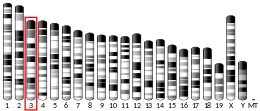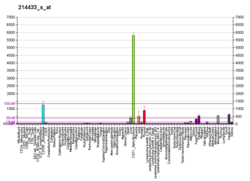SELENBP1
Selenium-binding protein 1 is a protein that in humans is encoded by the SELENBP1 gene.[5][6]
This gene product belongs to the selenium-binding protein family. Selenium is an essential nutrient that exhibits potent anticarcinogenic properties, and deficiency of selenium may cause certain neurologic diseases. It has been proposed that the effects of selenium in preventing cancer and neurologic diseases may be mediated by selenium-binding proteins. The exact function of this gene is not known.[6]
Interactions
SELENBP1 has been shown to interact with USP33.[7]
gollark: What happened to it?
gollark: Why is there a factorio *role* too?
gollark: I wanted to see what that did.
gollark: <@&452304848088465419>
gollark: Haskell: nice non-brackety flexible sintaxx.
References
- GRCh38: Ensembl release 89: ENSG00000143416 - Ensembl, May 2017
- GRCm38: Ensembl release 89: ENSMUSG00000068877 - Ensembl, May 2017
- "Human PubMed Reference:". National Center for Biotechnology Information, U.S. National Library of Medicine.
- "Mouse PubMed Reference:". National Center for Biotechnology Information, U.S. National Library of Medicine.
- Chang PW, Tsui SK, Liew C, Lee CC, Waye MM, Fung KP (February 1997). "Isolation, characterization, and chromosomal mapping of a novel cDNA clone encoding human selenium binding protein". Journal of Cellular Biochemistry. 64 (2): 217–24. doi:10.1002/(SICI)1097-4644(199702)64:2<217::AID-JCB5>3.0.CO;2-#. PMID 9027582.
- "Entrez Gene: SELENBP1 selenium binding protein 1".
- Jeong JY, Wang Y, Sytkowski AJ (February 2009). "Human selenium binding protein-1 (hSP56) interacts with VDU1 in a selenium-dependent manner". Biochemical and Biophysical Research Communications. 379 (2): 583–8. doi:10.1016/j.bbrc.2008.12.110. PMID 19118533.
Further reading
- Kim H, Kang HJ, You KT, Kim SH, Lee KY, Kim TI, et al. (June 2006). "Suppression of human selenium-binding protein 1 is a late event in colorectal carcinogenesis and is associated with poor survival". Proteomics. 6 (11): 3466–76. doi:10.1002/pmic.200500629. PMID 16645984.
- Huang KC, Park DC, Ng SK, Lee JY, Ni X, Ng WC, et al. (May 2006). "Selenium binding protein 1 in ovarian cancer". International Journal of Cancer. 118 (10): 2433–40. doi:10.1002/ijc.21671. PMID 16380993.
- Rual JF, Venkatesan K, Hao T, Hirozane-Kishikawa T, Dricot A, Li N, et al. (October 2005). "Towards a proteome-scale map of the human protein-protein interaction network". Nature. 437 (7062): 1173–8. Bibcode:2005Natur.437.1173R. doi:10.1038/nature04209. PMID 16189514.
- Stelzl U, Worm U, Lalowski M, Haenig C, Brembeck FH, Goehler H, et al. (September 2005). "A human protein-protein interaction network: a resource for annotating the proteome". Cell. 122 (6): 957–68. doi:10.1016/j.cell.2005.08.029. hdl:11858/00-001M-0000-0010-8592-0. PMID 16169070.
- Miyaguchi K (May 2004). "Localization of selenium-binding protein at the tips of rapidly extending protrusions". Histochemistry and Cell Biology. 121 (5): 371–6. doi:10.1007/s00418-004-0623-y. PMID 15108003.
- Porat A, Sagiv Y, Elazar Z (May 2000). "A 56-kDa selenium-binding protein participates in intra-Golgi protein transport". The Journal of Biological Chemistry. 275 (19): 14457–65. doi:10.1074/jbc.275.19.14457. PMID 10799528.
- Lanfear J, Fleming J, Walker M, Harrison P (March 1993). "Different patterns of regulation of the genes encoding the closely related 56 kDa selenium- and acetaminophen-binding proteins in normal tissues and during carcinogenesis". Carcinogenesis. 14 (3): 335–40. doi:10.1093/carcin/14.3.335. PMID 8453708.
- Czar MJ, Owens-Grillo JK, Dittmar KD, Hutchison KA, Zacharek AM, Leach KL, et al. (April 1994). "Characterization of the protein-protein interactions determining the heat shock protein (hsp90.hsp70.hsp56) heterocomplex". The Journal of Biological Chemistry. 269 (15): 11155–61. PMID 8157642.
- Dawson SJ, White LA (May 1992). "Treatment of Haemophilus aphrophilus endocarditis with ciprofloxacin". The Journal of Infection. 24 (3): 317–20. doi:10.1016/S0163-4453(05)80037-4. PMID 1602151.
- Bartolone JB, Birge RB, Bulera SJ, Bruno MK, Nishanian EV, Cohen SD, Khairallah EA (March 1992). "Purification, antibody production, and partial amino acid sequence of the 58-kDa acetaminophen-binding liver proteins". Toxicology and Applied Pharmacology. 113 (1): 19–29. doi:10.1016/0041-008X(92)90004-C. PMID 1553752.
- Veldscholte J, Berrevoets CA, Brinkmann AO, Grootegoed JA, Mulder E (March 1992). "Anti-androgens and the mutated androgen receptor of LNCaP cells: differential effects on binding affinity, heat-shock protein interaction, and transcription activation". Biochemistry. 31 (8): 2393–9. doi:10.1021/bi00123a026. PMID 1540595.
This article is issued from Wikipedia. The text is licensed under Creative Commons - Attribution - Sharealike. Additional terms may apply for the media files.




